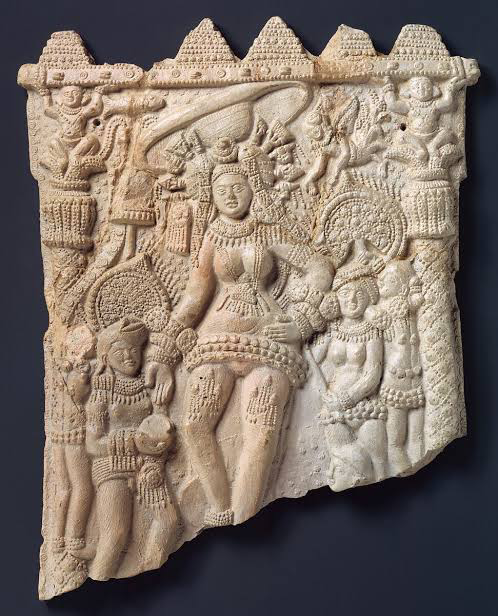Queens'
The Shunga Dynasty in ancient India (around 2nd century BCE) had notable queens who played significant roles in shaping history.
these queens exemplify how women in the Shunga Dynasty were agents of change through their contributions to the arts, culture, and historical documentation. They left a lasting legacy in Indian history, demonstrating the significant influence women could exert even in ancient times.
Certainly, here are more details about how these Shunga Dynasty queens shaped history:
प्राचीन भारत में शुंग राजवंश (लगभग दूसरी शताब्दी ईसा पूर्व) की उल्लेखनीय रानियाँ थीं जिन्होंने इतिहास को आकार देने में महत्वपूर्ण भूमिका निभाई।
ये रानियाँ इस बात का उदाहरण हैं कि शुंग राजवंश की महिलाएँ कला, संस्कृति और ऐतिहासिक अभिलेखन में अपने योगदान के माध्यम से कैसे परिवर्तन की वाहक थीं। उन्होंने भारतीय इतिहास में एक अमिट विरासत छोड़ी, जिससे यह प्रदर्शित होता है कि प्राचीन काल में भी महिलाएँ कितना महत्वपूर्ण प्रभाव डाल सकती थीं।
निश्चित रूप से, शुंग राजवंश की इन रानियों ने इतिहास को कैसे आकार दिया, इसके बारे में अधिक जानकारी यहाँ दी गई है:
Queen Agnimitra's Patronage of the Arts: Queen Agnimitra's support for theater and dance is well-documented. She is associated with the playwright Kalidasa, who composed some of his works during her reign. This era marked the golden age of Sanskrit drama, and her patronage contributed to the development of classical Indian theater. These artistic achievements not only entertained the people but also helped preserve and propagate cultural values.
रानी अग्निमित्रा द्वारा कलाओं को संरक्षण: रानी अग्निमित्रा का रंगमंच और नृत्य के प्रति समर्थन सर्वविदित है। उनका संबंध नाटककार कालिदास से है, जिन्होंने उनके शासनकाल में अपनी कुछ रचनाएँ रची थीं। यह युग संस्कृत नाटक के स्वर्णिम युग का प्रतीक था, और उनके संरक्षण ने शास्त्रीय भारतीय रंगमंच के विकास में योगदान दिया। इन कलात्मक उपलब्धियों ने न केवल लोगों का मनोरंजन किया, बल्कि सांस्कृतिक मूल्यों के संरक्षण और प्रसार में भी मदद की।
Queen Naganika's Contribution to Inscriptions: Queen Naganika's Nasik Cave inscription, dated around 2nd century BCE, is a significant historical document. It provides insights into the political, social, and economic aspects of the Shunga Dynasty's time. The inscription is written in Prakrit and Brahmi script and contains information about land grants, Buddhist donations, and her role as a benefactor.
शिलालेखों में रानी नागनिका का योगदान: लगभग दूसरी शताब्दी ईसा पूर्व का रानी नागनिका का नासिक गुफा शिलालेख एक महत्वपूर्ण ऐतिहासिक दस्तावेज़ है। यह शुंग वंश के समय के राजनीतिक, सामाजिक और आर्थिक पहलुओं की जानकारी प्रदान करता है। यह शिलालेख प्राकृत और ब्राह्मी लिपि में लिखा गया है और इसमें भूमि अनुदान, बौद्ध दान और एक दानदाता के रूप में उनकी भूमिका के बारे में जानकारी है।
Female Influence on Royal Governance: In addition to their cultural contributions, queens in the Shunga Dynasty may have played political roles behind the scenes. While direct evidence is scarce, it was common for queens to counsel and influence their husbands, the kings, in matters of governance and diplomacy. Their wisdom and counsel could have had a substantial impact on the kingdom's policies.
शाही शासन पर महिलाओं का प्रभाव: शुंग राजवंश में रानियों ने अपने सांस्कृतिक योगदान के अलावा, पर्दे के पीछे से राजनीतिक भूमिकाएँ भी निभाई होंगी। हालाँकि प्रत्यक्ष प्रमाण कम हैं, लेकिन रानियों द्वारा शासन और कूटनीति के मामलों में अपने पतियों, यानी राजाओं को सलाह देना और उन पर प्रभाव डालना आम बात थी। उनकी बुद्धिमत्ता और सलाह का राज्य की नीतियों पर गहरा प्रभाव पड़ा होगा।
Legacy in Indian History: The legacy of these queens and their contributions to the arts and historical documentation continued to influence subsequent dynasties and Indian culture as a whole. The artistic achievements and historical inscriptions from their time are invaluable sources for historians and scholars studying ancient India.
भारतीय इतिहास में विरासत: इन रानियों की विरासत और कला एवं ऐतिहासिक अभिलेखों में उनके योगदान ने बाद के राजवंशों और समग्र रूप से भारतीय संस्कृति को प्रभावित करना जारी रखा। उनके समय की कलात्मक उपलब्धियाँ और ऐतिहासिक शिलालेख प्राचीन भारत का अध्ययन करने वाले इतिहासकारों और विद्वानों के लिए अमूल्य स्रोत हैं।
In summary, Queen Agnimitra and Queen Naganika, along with other queens of the Shunga Dynasty, played pivotal roles as agents of change by promoting culture, leaving historical records, and possibly contributing to governance. Their influence extended far beyond their lifetimes, contributing to the rich tapestry of Indian history and culture.
संक्षेप में, रानी अग्निमित्रा और रानी नागनिका ने शुंग वंश की अन्य रानियों के साथ मिलकर संस्कृति को बढ़ावा देकर, ऐतिहासिक अभिलेख छोड़कर, और संभवतः शासन में योगदान देकर परिवर्तन के वाहक के रूप में महत्वपूर्ण भूमिका निभाई। उनका प्रभाव उनके जीवनकाल से कहीं आगे तक फैला रहा, और उन्होंने भारतीय इतिहास और संस्कृति के समृद्ध ताने-बाने में योगदान दिया।

Comments
Post a Comment